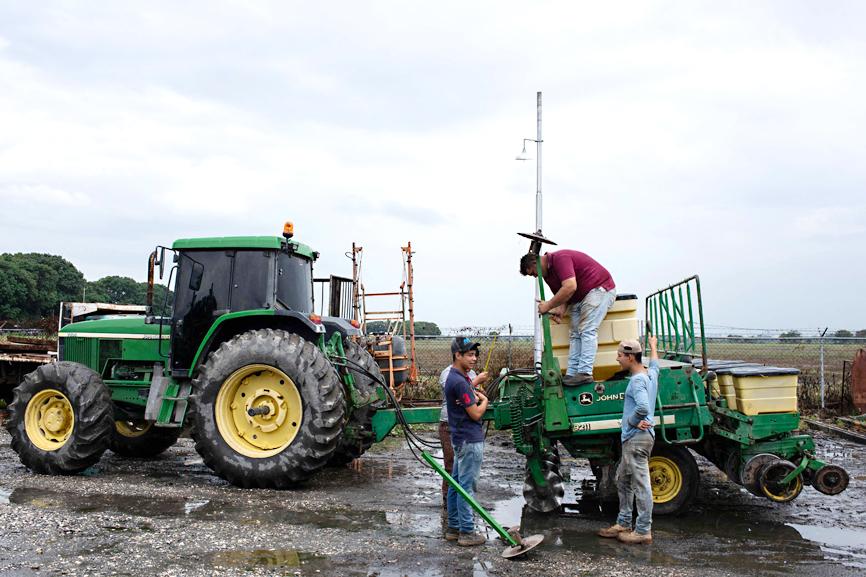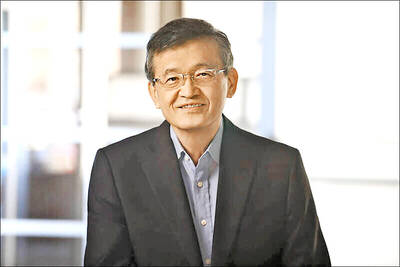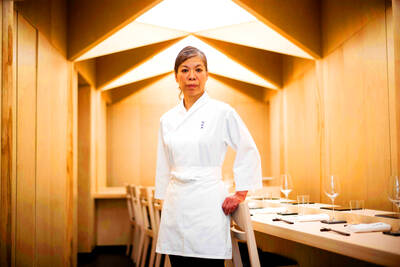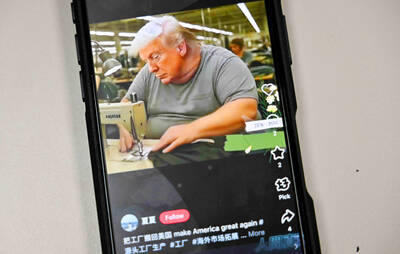The first rainy season downpour in Venezuela’s western region of Portuguesa has fallen and now it is time to plant corn, a staple in the South American country.
However, just like much of Latin America, the race is on to find enough fertilizer for the crops.
Russia’s invasion of Ukraine 10,000km away has limited the supply of the key agricultural supplement throughout the region.

Photo: AFP
About 80 percent of the 180,000 tonnes of fertilizers used annually in Venezuela are imported, mostly from Russia, but also from Ukraine and Belarus, the FEDEAGRO union of agricultural producers said.
Western sanctions against Russia and Belarus, as well as Ukraine’s difficulties in exporting while under siege, has left the whole of Latin America scrambling to find replacements.
Russia is the world’s largest exporter of fertilizers with more than 12 percent of the global market, but its sales have been virtually paralyzed by sanctions.
“Thank God we managed to buy Russian fertilizers in business talks in October and November, paid in December and they were able to arrive in February and March,” FEDEAGRO president Celso Fantinel said.
Fantinel said they are still short by about one-third of their needs, but the weather waits for no-one, and there is no time to find alternatives.
As it is “we’re producing 30 percent of our capacity” due to Venezuela’s economic crisis that saw the country suffer eight years of recession and four years of hyperinflation, said Ramon Bolotin, president of the PAI independent agricultural producers. “Even so, there aren’t enough fertilizers for this 30 percent.”
“Chemical fertilizers are essential,” he said, for a country where 3 percent of the 30 million population works in agriculture “to feed the other 97 percent.”
“We’ll work with what we have ... although in some places they will need to underdose,” Bolotin said.
For Venezuelan farmers, it is yet another headache in a country already suffering fuel shortages due to the collapse of its vital oil industry.
In Portuguesa, an agricultural region known as Venezuela’s “granary,” petrol station queues stretch for kilometers.
Venezuela’s farming sector was expecting to sow 250,000 hectares of corn, 50,000 hectares of rice, 60,000 hectares of sugarcane and 70,000 hectares of other products such as coffee and cacao, FEDEAGRO said.
The fertilizer shortfall is a massive obstacle. One hectare of corn can produce 9 tonnes of harvest, but that figure can fall to as low as 2.7 tonnes if conditions are not right.
The whole of Latin America faces the same issue, particularly its two agricultural giants. Last year, Brazil imported almost 81 percent of the 36.74 million tonnes of fertilizer it used, and 20 percent of that came from Russia, the government has said.
Argentina imported 60 percent of its 6 million tonnes, of which 15 percent came from Russia.
Mexico, Ecuador, Colombia and Peru are also, to a greater or lesser extent, dependent on Russian fertilizers.
In March, Ecuadorian President Guillermo Lasso said his government would subsidize fertilizer imports due to the “increase in the price of agricultural materials” sparked by the international crisis.
Horst Hobener, a corn grower in Turen, Portuguesa, said that prices have risen 120 percent in a matter of months.
The collapse of Venezuela’s oil industry has affected the petrochemical industry, which in the past covered the internal demand for fertilizers.
“This has been felt a lot,” FEDEAGRO vice president Osman Quero said. “In the last three years we have been sourcing the fertilizers ourselves” through intermediaries.
Farmers have asked the government to reactivate its petrochemical complex in the northern Carabobo State, which has been semi-paralyzed since 2017.
According to state oil company Petroleos de Venezuela SA, it has the capacity to produce 150,000 tonnes of nitrogenous and phosphate fertilizers a year.
Russian fertilizers used by farmers in Turen are made up of 10 percent nitrogen, 26 percent phosphorus and 26 percent potassium.
“We have two fundamental ingredients: urea [nitrogen] and phosphorus, and we would only need to import potassium chloride,” Fantinel said.
They are exploring other options, but the global shortfall has meant many exporters have suspended sales due to their own domestic needs.
Ruben Carrasco from the Lima Chamber of Commerce said that Russia is looking for ways to use third parties such as Norway to return to the market.
“Who knows, maybe next year other alternative sources will be tried,” Bolotin said.
Other commodities:
‧Gold for June delivery rose US$0.90 to US$1,842.10 an ounce, increasing 1.87 percent from a week earlier.
‧Silver for July delivery fell US$0.24 to US$21.67 an ounce, up 3.19 percent on the week, while July copper was unchanged at US$4.28 a pound, but rose 2.39 percent weekly.
Additional reporting by AP

Intel Corp chief executive officer Lip-Bu Tan (陳立武) is expected to meet with Taiwanese suppliers next month in conjunction with the opening of the Computex Taipei trade show, supply chain sources said on Monday. The visit, the first for Tan to Taiwan since assuming his new post last month, would be aimed at enhancing Intel’s ties with suppliers in Taiwan as he attempts to help turn around the struggling US chipmaker, the sources said. Tan is to hold a banquet to celebrate Intel’s 40-year presence in Taiwan before Computex opens on May 20 and invite dozens of Taiwanese suppliers to exchange views

Application-specific integrated circuit designer Faraday Technology Corp (智原) yesterday said that although revenue this quarter would decline 30 percent from last quarter, it retained its full-year forecast of revenue growth of 100 percent. The company attributed the quarterly drop to a slowdown in customers’ production of chips using Faraday’s advanced packaging technology. The company is still confident about its revenue growth this year, given its strong “design-win” — or the projects it won to help customers design their chips, Faraday president Steve Wang (王國雍) told an online earnings conference. “The design-win this year is better than we expected. We believe we will win

Chizuko Kimura has become the first female sushi chef in the world to win a Michelin star, fulfilling a promise she made to her dying husband to continue his legacy. The 54-year-old Japanese chef regained the Michelin star her late husband, Shunei Kimura, won three years ago for their Sushi Shunei restaurant in Paris. For Shunei Kimura, the star was a dream come true. However, the joy was short-lived. He died from cancer just three months later in June 2022. He was 65. The following year, the restaurant in the heart of Montmartre lost its star rating. Chizuko Kimura insisted that the new star is still down

While China’s leaders use their economic and political might to fight US President Donald Trump’s trade war “to the end,” its army of social media soldiers are embarking on a more humorous campaign online. Trump’s tariff blitz has seen Washington and Beijing impose eye-watering duties on imports from the other, fanning a standoff between the economic superpowers that has sparked global recession fears and sent markets into a tailspin. Trump says his policy is a response to years of being “ripped off” by other countries and aims to bring manufacturing to the US, forcing companies to employ US workers. However, China’s online warriors